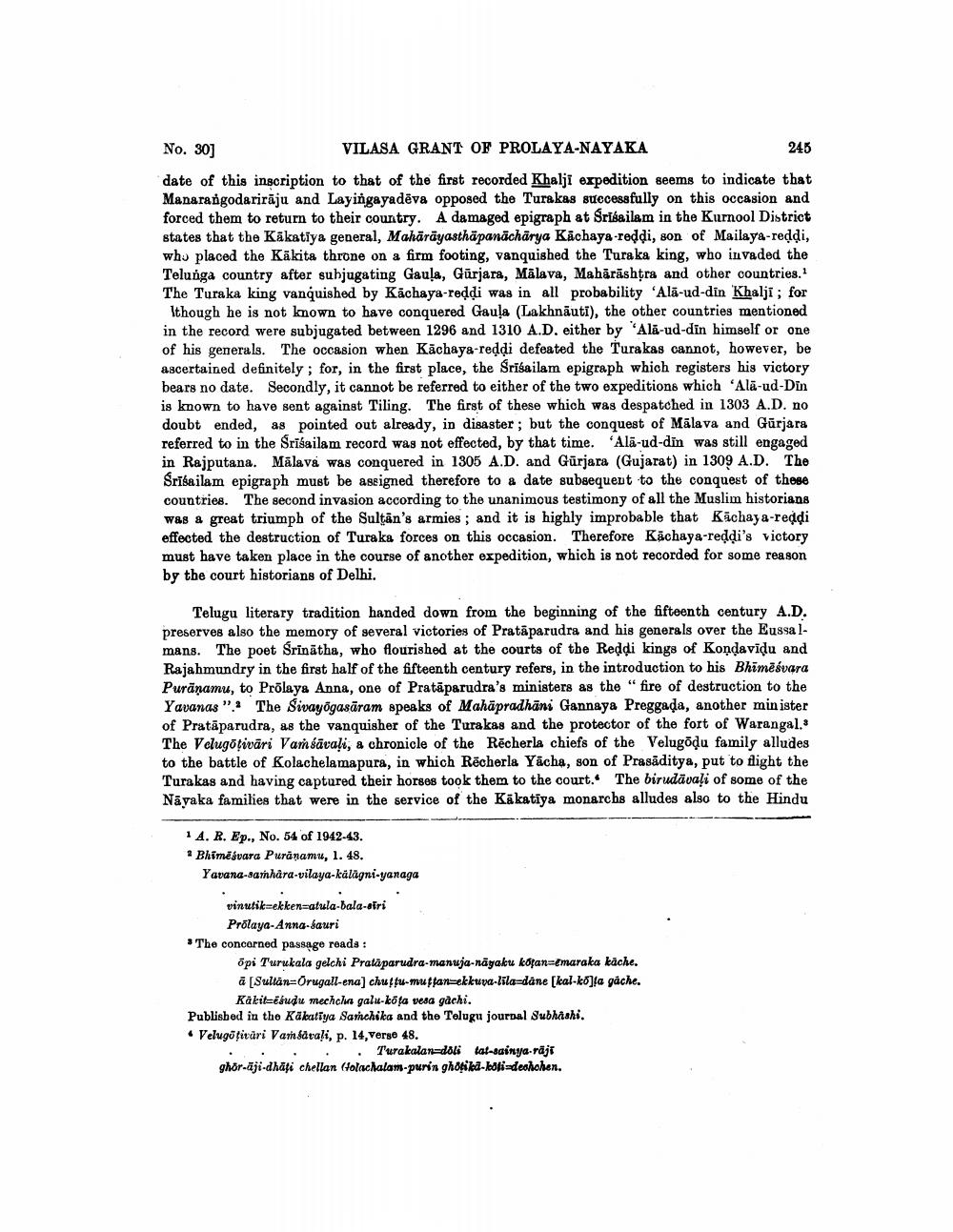________________
No. 30] VILASA GRANT OF PROLAYA-NAYAKA
245 date of this inscription to that of the first recorded Khalji expedition seems to indicate that Manarangodarirāju and Layingayadēva opposed the Turakas successfully on this occasion and forced them to return to their country. A damaged epigraph at Srisailam in the Kurnool District states that the Kakatiya general, Mahārāyasthāpanācharya Kāchaya-reddi, son of Mailaya-reddi, who placed the Kākita throne on a firm footing, vanquished the Turaka king, who invaded the Telunga country after subjugating Gaula, Gürjara, Mālava, Maharashtra and other countries. The Turaka king vanquished by Kachaya-reddi was in all probability 'Alā-ud-din Khalji; for Ithough he is not known to have conquered Gaula (Lakhnauti), the other countries mentioned in the record were subjugated between 1296 and 1310 A.D. either by 'Alā-ud-din himself or one of his generals. The occasion when Kāchaya-reddi defeated the Turakas cannot, however, be ascertained definitely ; for, in the first place, the Srisailam epigraph which registers his victory bears no date. Secondly, it cannot be referred to either of the two expeditions which 'Alā-ud-Din is known to have sent against Tiling. The first of these which was despatched in 1303 A.D. no doubt ended, as pointed out already, in disaster; but the conquest of Mālava and Gurjara referred to in the Srisailam record was not effected, by that time. 'Alā-ud-din was still engaged in Rajputana. Mālavå was conquered in 1305 A.D. and Gurjara (Gujarat) in 1309 A.D. The Srīsailam epigraph must be assigned therefore to a date subsequent to the conquest of these countries. The second invasion according to the unanimous testimony of all the Muslim historians was a great triumph of the Sultan's armies; and it is highly improbable that Kachaya-reddi effected the destruction of Turaka forces on this occasion. Therefore Kachaya-reddi's victory must have taken place in the course of another expedition, which is not recorded for some reason by the court historians of Delhi.
Telugu literary tradition handed down from the beginning of the fifteenth century A.D. preserves also the memory of several victories of Prataparudra and his generals over the Eussa lmans. The poet Srinatha, who flourished at the courts of the Reddi kings of Kondavidu and Rajahmundry in the first half of the fifteenth century refers, in the introduction to his Bhimësvara Purānamu, to Prolaya Anna, one of Pratāparudra's ministers as the "fire of destruction to the Yavanas ".2 The Sivayogasāram speaks of Mahāpradhāni Gannaya Preggada, another minister of Pratāparudra, as the vanquisher of the Turakas and the protector of the fort of Warangal. The Velugotivāri Vamsārali, a chronicle of the Recherla chiefs of the Velugõdu family alludes to the battle of Kolachelamapura, in which Rēcherla Yacha, son of Prasāditya, put to flight the Turakas and having captured their horses took them to the court. The birudāvați of some of the Näyaka families that were in the service of the Kakatiya monarchs alludes also to the Hindu
14. R. Ep., No. 54 of 1942-43. Bhimësuara Puranamu, 1. 48. Yavana-aanhara-vilaya-kálagni-yanaga
vinutik-ekken-atula-bala-siri
Prolaya-Anna-sauri * The concerned passage roads :
Opi Turukala gelchi Prataparudra-manuja-nagaku kotan=emaraka kache. a [Sultan Orugall-ena) chuffu-muffan-ekkuva-liladane [kal-kolla pache.
Kalitesudu mechcha galu-kõta vesa gachi. Published in the Kakatiya Sanchika and the Telugu journal Subhashi. • Velugů fivari Varsavali, p. 14, Verge 48.
. . . Turakalandoli tat-sainya-raji ghör-Uji-dhafi chellan Golachalam-purin ghotikd-ldfideshohen.




